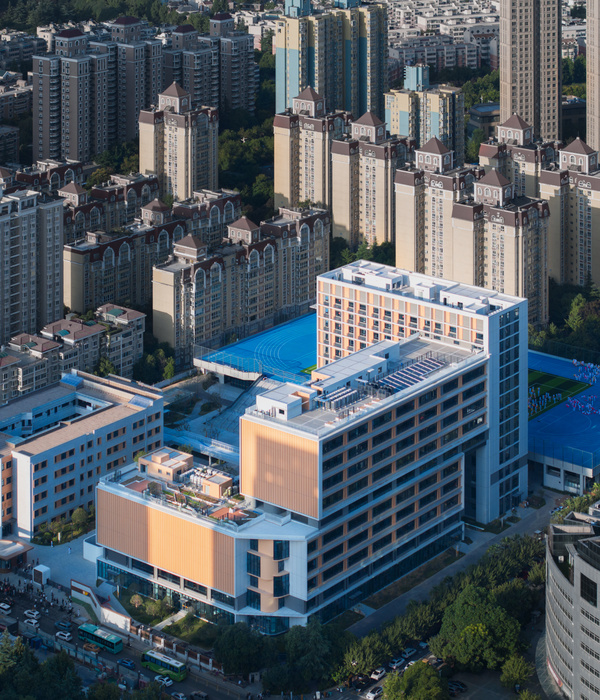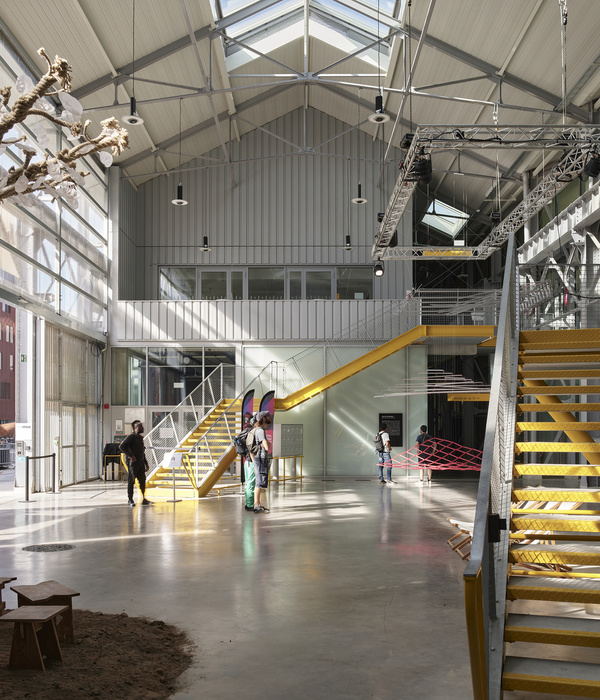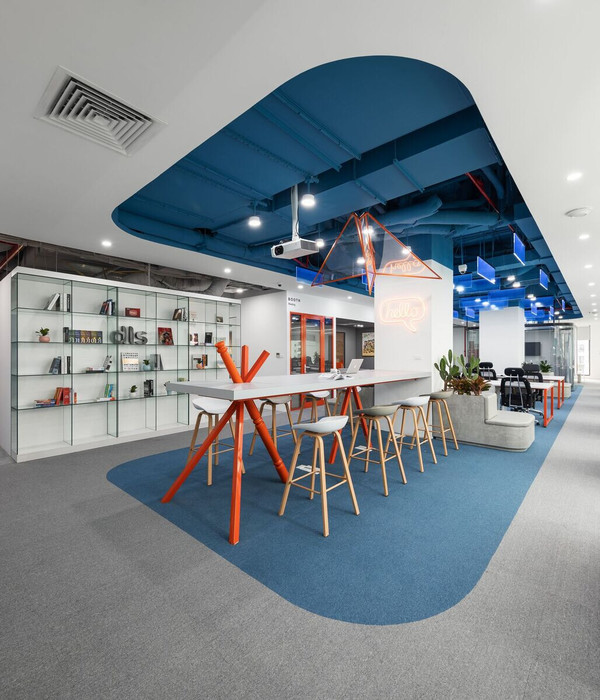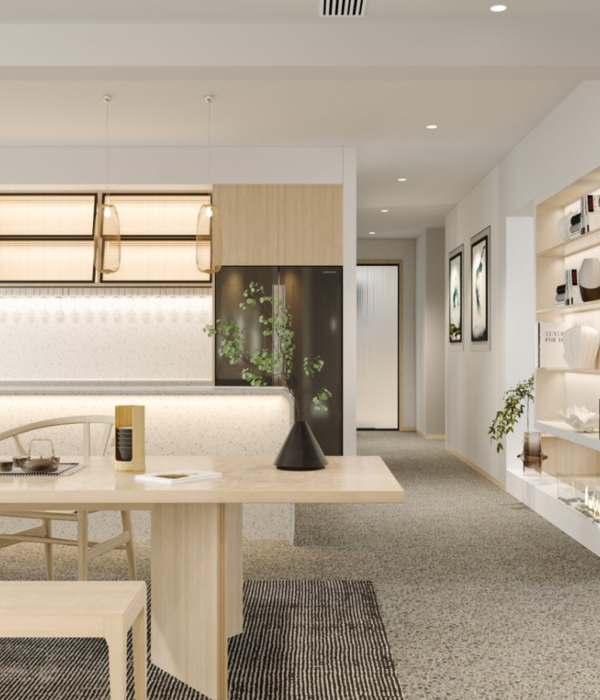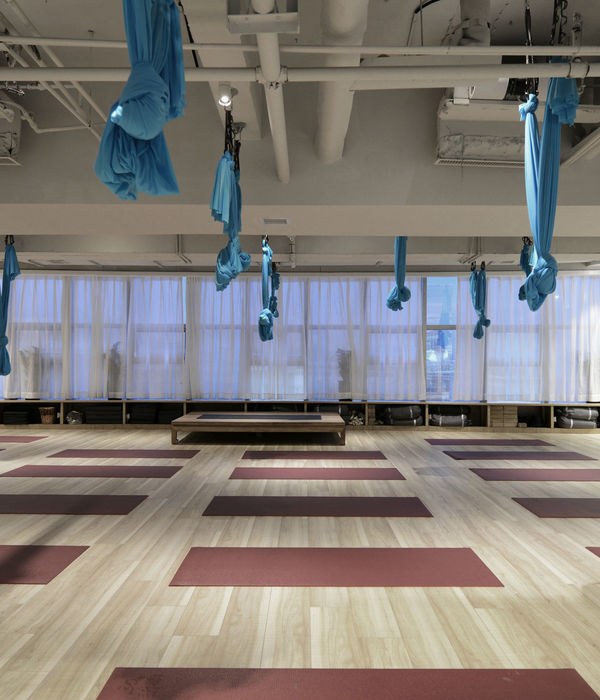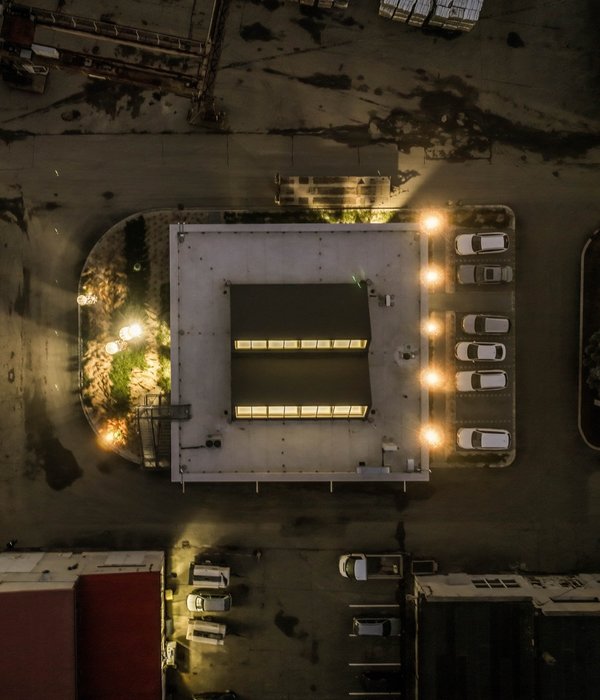- 项目名称:四川沱牌舍得文化中心
- 地理位置:四川省沱牌镇
- 建筑层数:地上3层,地下1层
- 结构材料:钢筋混凝土框架结构
- 摄影:存在建筑-建筑摄影
距离成都和重庆均为二百公里左右的沱牌镇是四川的一个企业小镇,是中国老字号酒厂舍得酒的酿造基地。或许因为悠静的地理位置,沱牌镇似乎同时保留了中国60-70年代工业城镇和乡村聚落的氛围。文化中心坐落在舍得生产区的门前,与涪江和一所公园隔路相望。
The project is in a company town named Tuopai Zhen in Sichuan where the distillery of Shede, an old liquor brand in China, is based. The closest large cities are Chengdu and Chongqing, both are approximately 200 kilometers away. Partially due to its relatively quiet location, Tuopai Zhen seems to maintain both the ambience of an industrial town and a rural village before the economic reform that was commenced in China in the late 1970’s. The specific site for this visitor’s center is situated in front of the production campus of Shede near a main thoroughfare with a park and a river on the other side.
▼鸟瞰:由生产区看东南侧的公园和涪江,aerial view: view to the park and the river from the production campus ©存在建筑-建筑摄影
▼舍得文化中心西北侧生产区,aerial view to the production campus on the north side ©存在建筑-建筑摄影
文化中心融合了多种功能,包括酒文化博物馆、宾馆、宴会厅和研发中心等,为游客们拉开了酒厂之旅的序幕。
For tourists, the visitor’s center is the prelude before departing for a tour of the Shede distilling facilities and has a well-mixed program, including a museum for liquor culture, a hotel, a dining theater, a R&D center, among others.
▼文化中心东侧,view to the visitor’s center from east ©存在建筑-建筑摄影
▼主立面,main facade ©存在建筑-建筑摄影
▼远看北立面,a distant view to the north facade ©存在建筑-建筑摄影
▼东南侧立面,southeast facade ©存在建筑-建筑摄影
▼大堂立面,lobby facade ©存在建筑-建筑摄影
▼体验中心与配套办公楼之间,between the visitor center and the office building ©存在建筑-建筑摄影
经过调研,我们意识到沱牌镇吸引游客的秘诀不仅在于名酒,也取决于其纯净的自然景色和宁静的地域气质。我们的设计试图通过保留这些品质来吸引渴望远离都市喧嚣的人们。文化中心综合体被视作连接工业园区与自然景观的纽带,其建筑空间由一系列带内院的馆所以线性排列的方式组成,而形式语言则由深檐和木板墙等低调的本土化词汇所构建。
After much study, we come to realize the reasons why vacationists would come to Tuopai Zhen have to do not only with the famous liquor but also with the pristine natural landscape as well as the tranquil feeling of the locale. Our design intends to preserve these qualities that attract the people trying to get away from the hustles and bustles of the metropolises. While the building complex of the visitor’s center serves as a connection-transition between the Shede campus and the woodsy landscape, the architecture of the center is spatially organized as a series of smaller pavilions with central courtyards arranged in a linear fashion and its formal language is based on a low-key vernacular vocabulary of deep eaves and wood-paneled walls.
▼透过竹林看三层客房,view to the hotel building through the bamboo forest ©存在建筑-建筑摄影
▼办公楼立面,office building facade ©存在建筑-建筑摄影
▼办公楼南侧山墙,the gable wall of the office building ©存在建筑-建筑摄影
▼从景观草坪看南立面,south facade viewed from the lawn ©存在建筑-建筑摄影
▼景观水池看南立面,south facade viewed from the pool ©存在建筑-建筑摄影
▼三层俯瞰内庭院,the 3-storey inner courtyard ©存在建筑-建筑摄影
▼三层客房外廊夜景,the veranda on the third floor of the hotel building ©存在建筑-建筑摄影
▼宴会厅立面,dining theater facade ©存在建筑-建筑摄影
▼展厅立面,exhibition centre facade ©存在建筑-建筑摄影
▼展厅立面细部,facade detail ©存在建筑-建筑摄影
馆所的断面中,无梁混凝土楼板从中部朝两侧悬挑而出,好拟一把张开的伞。这把“伞”从檐口到中心处逐渐由薄变厚,并在最厚的区域承担藏匿暖通管道的需要。
The cross-section of the typical pavilion resembles that of an umbrella with beam-less concrete roof cantilevering out from the center. The thickness of the sloping roof canopy changes gradually, thin at the eaves and thick at the base, where the air-conditioning ductworks are concealed.
▼大堂后景观台阶与水景,the stair and the water landscape ©存在建筑-建筑摄影
▼伞式结构体系,an umbrella-shaped structure system ©存在建筑-建筑摄影
▼无梁斜面清水混凝土屋顶,the beam-less concrete roof ©存在建筑-建筑摄影
▼展厅,exhibition hall ©存在建筑-建筑摄影
▼顶层客房区休闲空间,leisure area of the guest room on the rooftop ©存在建筑-建筑摄影
▼顶层客房区庭院,guest room courtyard ©存在建筑-建筑摄影
▼双层挑檐,the double-level cantilever roof ©存在建筑-建筑摄影
▼板墙立面,panel facade ©存在建筑-建筑摄影
▼板墙立面细部 ,panel facade detail ©存在建筑-建筑摄影
▼深檐下的格栅窗细部,the lattice windows sheltered by the deep eave ©存在建筑-建筑摄影
▼场地平面图,site plan
▼1层平面图,1F plan
▼2层平面图,2F plan
▼3层平面图,3F plan
▼南立面图,south elevation
▼剖面图,sections
客户: 沱牌舍得酒业股份有限公司 地点: 四川省沱牌镇 主持设计: 张永和, 鲁力佳 项目团队: 梁小宁,黄舒怡,张博文,柳超; 室内设计: Simon Lee,曾湘燕,张敏,李帅 合作设计: 中国建筑西南设计研究院 建筑面积: 22592 M2 建筑层数: 地上3层 地下1层 结构材料: 钢筋混凝土框架结构 设计时间: 2017 竣工时间: 2019 摄影: 存在建筑-建筑摄影
Client: Sichuan Tuopai Shede Wine Co., Ltd. Location: Tuopai Zhen, Sichuan, China Principal Architects: Yung Ho Chang, Lijia Lu Project Team: Liang Xiaoning, Huang Shuyi, Zhang Bowen, Liu Chao; Interior Design: Simon Lee, Zeng Xiangyan, Zhang Min, Li Shuai Collaboration: China Southwest Architectural Design and Research Institute Corp.,Ltd Building Area: 22592 M2 Building Storey: 3 floors above ground, 1 floor underground Structure and Material: Concrete framework Design Period: 2017 Completion Time: 2019 Photos: Arch-Exist Photography
{{item.text_origin}}





